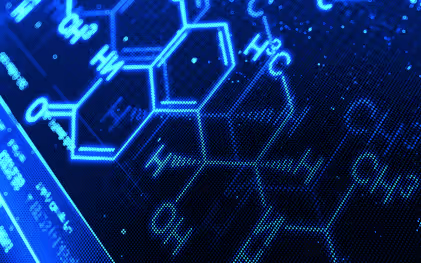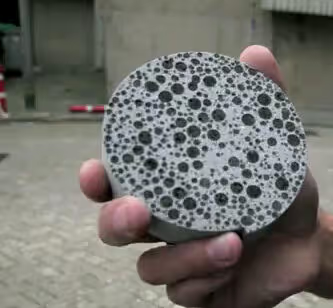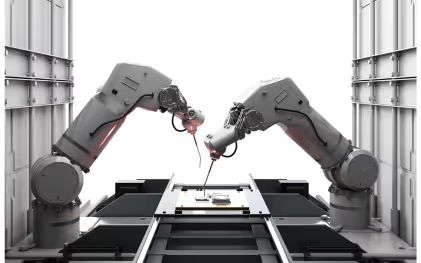R&D in 2025: Five Trends You Need to Know
What will shape the future of R&D in 2025? How will trends like sustainability, hyperautomation, and data-driven innovation redefine the way teams work? And what role will next-generation materials play in solving the challenges of tomorrow? For those seeking answers to these pressing questions, the latest insights reveal a dynamic landscape of change and opportunity.
2025 marks the midpoint of a decade defined by technological, political, and societal upheaval, with Germany playing a pivotal role. The High-Tech Strategy 2025 is the government’s response, aiming to provide fresh momentum for the economy and science through a forward-looking research and innovation policy. According to its website, the goal is to “position Germany at the forefront of the next technological revolutions, secure jobs domestically, and safeguard prosperity.” Concurrently, the strategy aims to enhance global competitiveness and address pressing challenges of our time.
Research and Development (R&D) play a central role in this transformation. They provide the foundation for sustainable innovations, unlock next-generation technologies, and bolster economic resilience. However, growing innovation pressures and increasing complexity demand a paradigm shift in how R&D teams approach their work and processes.
In this article, we explore five key trends set to shape the R&D landscape in 2025. From developing sustainable materials to leveraging data-driven strategies, we’ll uncover the central themes in research and development.
In this article, we explore five key trends set to shape the R&D landscape in 2025. From developing sustainable materials to leveraging data-driven strategies, we’ll uncover the central themes in research and development.
Trend #1: Sustainability
Sustainability remains a driving force for innovation in R&D in 2025. Companies face the dual challenge of complying with stricter regulations while meeting the growing demand for resource-efficient, environmentally friendly products. Industries such as automotive, construction, and packaging are increasingly adopting circular economy models.

Strategies that enable the reuse and recycling of materials to reduce waste and counteract resource scarcity are gaining prominence. A notable example in the automotive sector is the expanded use of recycled plastics. These materials not only reduce environmental impact but also lessen dependency on critical resources like lithium and aluminium. In the packaging industry, sustainable alternatives are coming to the fore: biodegradable plastics and reusable packaging systems are increasingly replacing traditional single-use materials.
Another key area of focus is emissions reduction technologies. Carbon Capture and Utilization (CCU) enables companies to not only capture CO₂ but also repurpose it as a resource. For instance, Covestro uses captured CO₂ to produce polyols—an essential component of polyurethanes found in foams. This approach saves fossil resources and lowers the carbon footprint of products. These developments highlight that sustainability extends beyond ecological considerations, presenting economic opportunities by reducing costs and opening new markets.
For R&D teams, this requires a fundamental shift. Digital tools such as material data platforms and AI-driven analyses are pivotal in optimizing material lifecycles and accelerating innovative solutions. Sustainability is thus evolving from a regulatory obligation to a strategic driver of long-term success.
Trend #2: Next-Generation Materials
Next-generation materials are unlocking unprecedented possibilities for product development, use, and recycling. Advanced technologies surpassing the limits of traditional materials allow for tailored properties and sustainable solutions.

One promising approach is “Engineered Living Materials” (ELMs). These materials, based on living cells acting as “material factories,” produce biopolymer-based components and create structures capable of self-regeneration or adaptation. A concrete example is self-healing concrete developed by Delft University researchers.
This material incorporates bacterial spores and calcium lactate as a nutrient. When cracks form and water enters, the bacteria activate, producing calcium carbonate (limestone) to fill and seal the cracks. Applications range from construction to biocompatible implants in medicine, showcasing how interdisciplinary research in biotechnology, genetics, and engineering is revolutionizing materials.

Programmable materials, capable of adjusting physical properties in response to stimuli such as electrical impulses or temperature, are another groundbreaking innovation. These materials find applications in robotics, aerospace, and electronics, enabling them to adapt to extreme conditions and introduce new functionalities. Metamaterials, characterized by specially designed internal structures, are also a focal point of research. These materials offer exceptional properties such as ultralightweight composition, sound insulation, and impact resistance. Bio-inspired designs, such as spinodal structures, enhance both durability and sustainability—an essential advantage for industries like mobility and energy, which continuously seek more efficient solutions.
Smart materials that dynamically respond to environmental factors such as light or humidity will gain further prominence in 2025. They contribute to extending product lifespans, reducing energy consumption, and are used in self-regulating building systems and energy-efficient processes. Visionary concepts like Living Material Systems, inspired by natural processes, adapt autonomously to their environment, harvest clean energy, or repair themselves. Initiatives like the livMatS project at the University of Freiburg demonstrate how these developments address both technological challenges and societal considerations such as acceptance and sustainability.
For R&D teams, these advancements represent immense potential—not just for opening new research fields but for fundamentally transforming product development. Digital tools and AI-driven analyses enable precise design and simulation of material properties, creating tailored solutions for specific applications. Next-generation materials redefine the boundaries of possibility, driving the innovation that will shape tomorrow’s technologies.
Trend #3: Hyperautomation
Hyperautomation heralds a new era of efficiency in R&D. Unlike traditional automation, it integrates advanced technologies such as Artificial Intelligence (AI), Robotic Process Automation (RPA), and machine learning to fully automate time-consuming and repetitive tasks.

In data-intensive areas like material testing, hyperautomation unleashes its potential: accelerating processes, minimizing errors, and freeing up resources for more complex tasks.
A key aspect of hyperautomation is the seamless integration of disparate data sources and systems. This allows R&D teams to automate tasks such as consolidating test results from various lab systems or generating reports. Such streamlined workflows save time while enhancing transparency and traceability in complex R&D processes.
Hyperautomation also opens new possibilities in material development through AI-powered algorithms. Simulations and analyses can be automated using historical data to identify optimal testing strategies. These technologies relieve R&D teams of routine tasks while enabling creative and strategic work.
The comprehensive deployment of intelligent technologies makes hyperautomation a critical lever for shortening development timelines, improving quality, and bringing innovations to market faster. For R&D teams, this signifies a shift toward more efficient, flexible, and future-ready processes.
Trend #4: Data-Driven Material Development
The ability to systematically analyse and leverage data will be a decisive success factor for R&D in 2025. Growing volumes of data from material tests, simulations, and production processes hold vast potential for informed decision-making and streamlined development processes. A clear data strategy enables R&D teams to not only anticipate trends but also design materials that meet future demands.

A cornerstone of data-driven development is the integration of diverse data sources into a central platform. Historical test results, production parameters, and simulation data can be combined to provide a comprehensive understanding of material properties and potential applications. These material intelligence platforms foster transparency and enable precise, data-based predictions, such as optimal formulations or material behaviour under specific conditions.
AI-driven analyses add a new dimension to decision-making. Patterns in data that would be nearly impossible to detect manually can be automatically identified, accelerating innovation processes. In material development, this translates to learning from past projects and deliberately planning the next generation of materials.
Real-world testing can be replaced by simulations, which significantly shortens development cycles, minimizes risks and creates space for innovative solutions.
Technologies like digital twins—a virtual representation of a physical object—further extend the possibilities. Real-world tests can be replaced by simulations, significantly reducing development cycles, minimizing risks, and creating space for more sustainable and innovative solutions. For R&D teams, this provides a crucial advantage in responding swiftly to tomorrow’s challenges.
Data-driven development transforms data into a key resource for R&D success. Teams that strategically and efficiently use data can not only respond to changes faster but also strengthen their organisation’s long-term innovative capacity and secure competitive advantages.
Trend #5: Collaboration
Material development is becoming increasingly complex, and the lines between lab, production, and research are blurring. To address these challenges, R&D teams are turning to interdisciplinary collaboration and digital networking. Modern R&D projects require continuous knowledge and data exchange across departments and disciplines.

Chemists, engineers, data scientists, and sustainability and regulatory experts work together on solutions that are not only technologically innovative but also sustainable and marketable.
Digital platforms play a crucial role in this new form of collaboration. They allow teams to work on a common basis across departments and locations. Material tests, simulation results, and production parameters are no longer viewed in isolation but embedded in a holistic context. These approaches help R&D teams tackle complex challenges such as developing sustainable materials or integrating new technologies more effectively.
A practical example demonstrates how interdisciplinary teams drive innovation: In a project aimed at reducing CO₂ emissions, chemists developed a novel catalyst, engineers assessed its scalability for production, and data scientists optimised the process’s efficiency through simulation models. This close collaboration resulted not only in faster outcomes but also a successful market launch.
In addition to technological advancements, soft skills are gaining importance. Companies promote cross-disciplinary collaboration through agile working methods and an open communication culture. Teams that effectively share knowledge and work together on problem-solving benefit from shorter development cycles and enhanced innovation.
Collaboration and interdisciplinarity are more than just trends for 2025—they represent a fundamental shift in material R&D. For R&D teams, this approach is essential to meeting the growing demands of the market and society.
Conclusions - the Five R&D Trends in 2025
The five trends for 2025—ranging from sustainability and hyperautomation to data-driven development and interdisciplinary collaboration—illustrate how dynamic the world of R&D will continue to be. Amidst these developments, one common denominator stands out: Material Intelligence.
Material Intelligence represents the ability to intelligently connect data, technologies, and people to make better decisions and bring innovative materials to market faster. It is more than just a technological solution—it is a strategic approach that makes challenges in material development manageable.
Whether it’s automating processes, making effective use of data, or connecting experts across disciplines, Material Intelligence lays the foundation for unlocking the full potential of modern technologies. Teams adopting this approach not only meet today’s challenges but also shape the future of material research.

For more information on LabVs Material Intelligence Platform (MIP), please check out this page.
